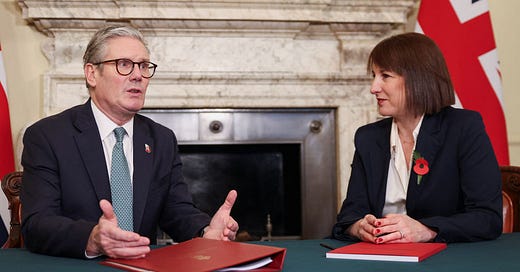The Walls Close In
A tough spending review just got tougher – what are the government’s options?
Downing Street’s attention is, naturally, on foreign policy at the moment, given Donald Trump’s trashing of the geopolitical order and the need to support Ukraine.
At the same time, though, ministers in domestic briefs are grappling with the consequences of a brutal spending review that’s getting tougher with every passing week, in part because of the global uncertainty created by Trump.
Back in October, when Rachel Reeves presented her first budget I wrote:
“The image that kept occurring to me as I read through the details….was of an Indiana Jones style adventurer stuck in a booby-trapped cave with the walls closing in. Yesterday’s announcements were the equivalent of slowing down the mechanism using a strategically placed rock. Imminent death is averted but only for so long.”
Well the walls are still closing in and it’s not clear what the next move is. Any hopes of short term improvements in the economic position have been dashed, indeed there is more downside risk than the Office of Budget Responsibility (OBR) acknowledged just a few months ago.
Exactly how tight things are was made clear when Starmer went to Washington armed with a pledge to boost defence spending to 2.5% of GDP. To ensure that Reeves was comfortable with the announcement an equivalent cut to the international aid budget was made, leading to the resignation of development minister Anneliese Dodds.
While aid has never been popular with the public, this is an astonishingly brutal cut. Given how much of that budget has already been diverted to paying for asylum seekers’ accommodation, and how much of the rest is already committed to multilateral funds, there is almost nothing left for the bilateral programmes that are so important to soft power relationships (as well as helping millions of people). Putting aside the wisdom of doing this at a time when USAID is being gutted, and China is making ever deeper inroads into the governance of low-income countries, it’s indicative of how Reeves and Starmer see the fiscal situation.
Though there is lot of unhappiness amongst MPs about the aid cut – many of whom previously worked in the development sector – it won’t lead to a revolt. Not only is it not a big issue for most voters but there is also a desire to give Starmer space to manage the Ukraine crisis. And, more cynically, there are rumours of a reshuffle on the horizon which is always a handy way to keep people quiet.
But there are limits to MPs’ patience. Some of the proposals being considered for future savings seem likely to provoke a lot more pushback and there is almost nothing available for positive pledges that could help win public support. The key section in Dodd’s resignation letter – that many colleagues nodded along to – argued that a different approach to the spending review was necessary:
“I also expected we would collectively discuss our fiscal rules and approach to taxation, as other nations are doing. Even 3% [of GDP on defence spending] may only be the start, and it will be impossible to raise the substantial resources needed just through tactical cuts to public spending.”
This is not where Reeves and Starmer are at the moment: they are determined to stick to election pledges on tax (albeit the NICs employers’ rise already pushed the boundaries of what had been promised) and there is understandable nervousness about more borrowing.
So in the rest of this post I’m going to look at the fiscal situation heading in the OBR forecast due in a few weeks, and the spending review. Then I’ll look at where cuts are likely to fall and finish with what alternative options might be available to the government to manage a fiscal squeeze that could yet get a lot worse.
Keep reading with a 7-day free trial
Subscribe to Comment is Freed to keep reading this post and get 7 days of free access to the full post archives.




